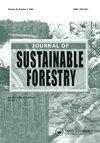Development of Mixed-Effects Individual-Tree Diameter Increment Model for Casuarina Equisetifolia Considering the Effects of Tree-Size Diversity, Tree Density Reduction, and Climate
IF 1.8
4区 农林科学
Q3 FORESTRY
引用次数: 1
Abstract
ABSTRACT Based on the data provided by the 6th (1998), 7th (2003), and 8th (2008) National Forest Inventory (NFI) in Hainan Province, southern China, we developed an individual-tree diameter increment model considering tree-size diversity, tree density reduction, and climate for Casuarina equisetifolia. Since the data was longitudinal and had a nested structure, we used a linear mixed-effects approach to construct the mixed-effects model based on sample plot effects. And we applied the method of 10-fold cross-validation to test the basic model without random effects and final mixed-effects model. The results indicate that natural logarithm of initial DBH (logDBH), sum of basal area of trees larger than objective tree (BAL), soil thickness (ST), Gini coefficient of DBH diversity for residual trees (GCres), and mean coolest month temperature (MCMT) had significant impact on the individual-tree diameter increment for Casuarina equisetifolia. Comparing with basic model, the final mixed-effects model performance was greatly improved. In the model validation, the mixed-effects model also showed a better fitting goodness. The individual-tree diameter increment models of Casuarina equisetifolia developed in this study will provide a good basis for estimating and predicting growth of Casuarina equisetifolia forests over larger areas.考虑树木大小多样性、密度降低和气候影响的木麻黄混合效应个体树径增量模型的建立
摘要基于第6次(1998)、第7次(2003)和第8次(2008)全国森林资源清查(NFI)提供的数据,建立了考虑树径多样性、树密度减少和气候因素的木麻黄单株径增长模型。由于数据具有纵向和嵌套结构,我们采用线性混合效应方法构建基于样本图效应的混合效应模型。采用10倍交叉验证的方法对无随机效应的基本模型和最终混合效应模型进行检验。结果表明,初始胸径自然对数(logDBH)、大于目标树的基材面积总和(BAL)、土壤厚度(ST)、残馀树胸径多样性基尼系数(GCres)和平均最冷月温度(MCMT)对木麻黄单株径增长有显著影响。与基本模型相比,最终混合效果模型的性能得到了很大的提高。在模型验证中,混合效应模型也表现出较好的拟合优度。本研究建立的木麻黄单株径增长模型将为更大范围内木麻黄林分生长的估算和预测提供良好的依据。
本文章由计算机程序翻译,如有差异,请以英文原文为准。
求助全文
约1分钟内获得全文
求助全文
来源期刊

Journal of Sustainable Forestry
Social Sciences-Geography, Planning and Development
CiteScore
3.90
自引率
12.50%
发文量
42
期刊介绍:
Journal of Sustainable Forestry publishes peer-reviewed, original research on forest science. While the emphasis is on sustainable use of forest products and services, the journal covers a wide range of topics from the underlying biology and ecology of forests to the social, economic and policy aspects of forestry. Short communications and review papers that provide a clear theoretical, conceptual or methodological contribution to the existing literature are also included in the journal.
Common topics covered in the Journal of Sustainable Forestry include:
• Ecology, management, recreation, restoration and silvicultural systems of all forest types, including urban forests
• All aspects of forest biology, including ecophysiology, entomology, pathology, genetics, tree breeding, and biotechnology
• Wood properties, forest biomass, bioenergy, and carbon sequestration
• Simulation modeling, inventory, quantitative methods, and remote sensing
• Environmental pollution, fire and climate change impacts, and adaptation and mitigation in forests
• Forest engineering, economics, human dimensions, natural resource policy, and planning
Journal of Sustainable Forestry provides an international forum for dialogue between research scientists, forest managers, economists and policy and decision makers who share the common vision of the sustainable use of natural resources.
 求助内容:
求助内容: 应助结果提醒方式:
应助结果提醒方式:


